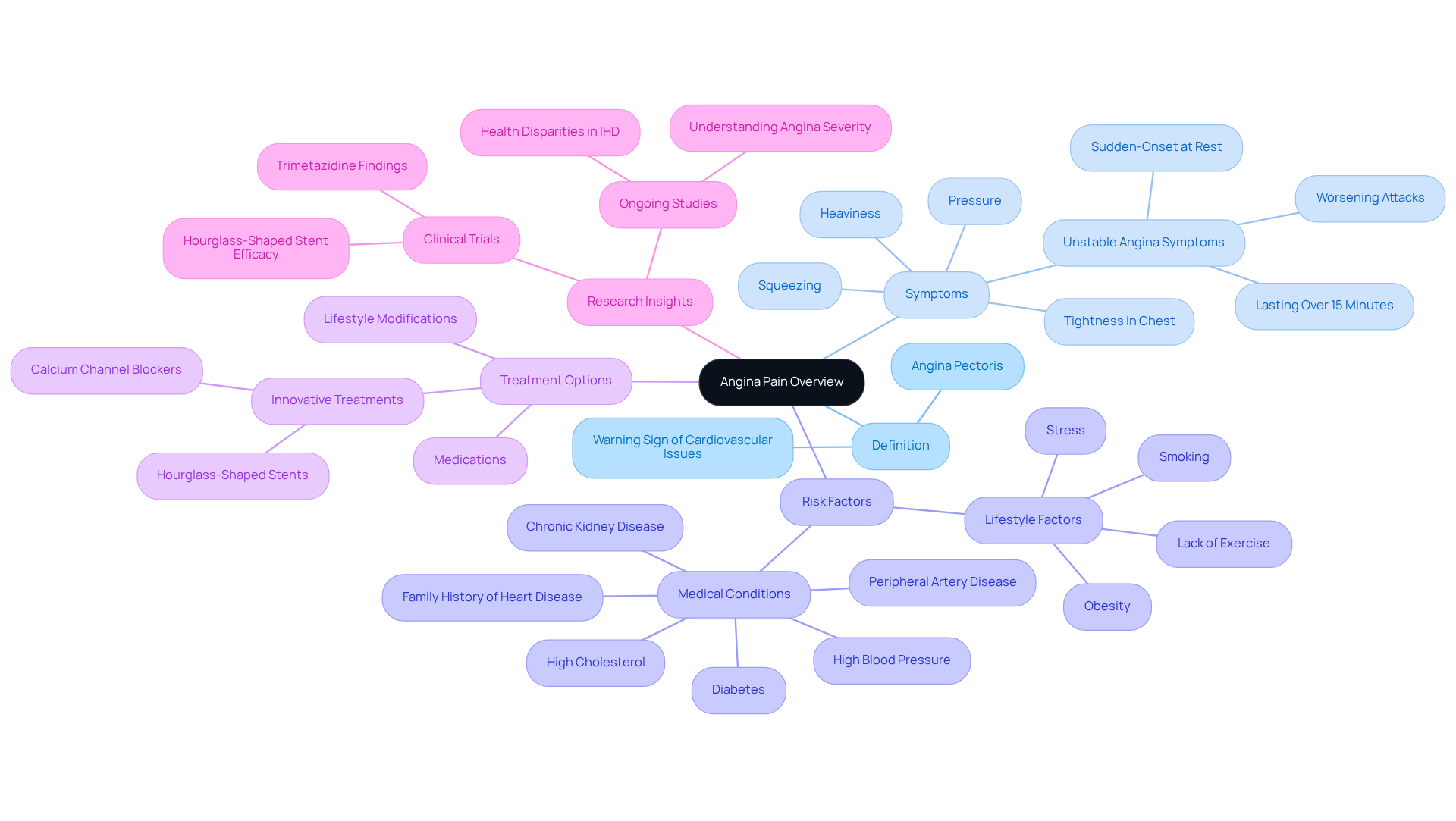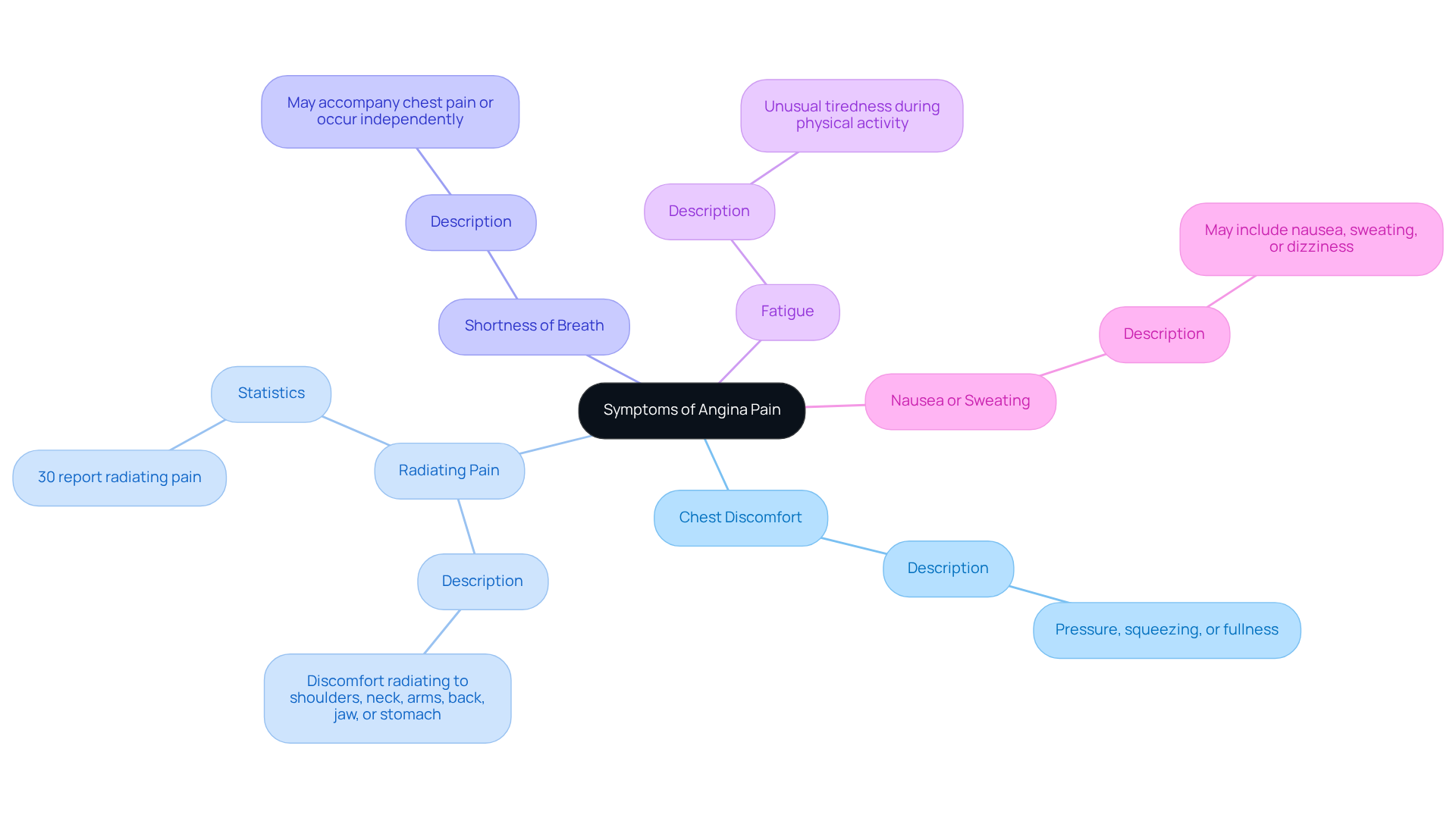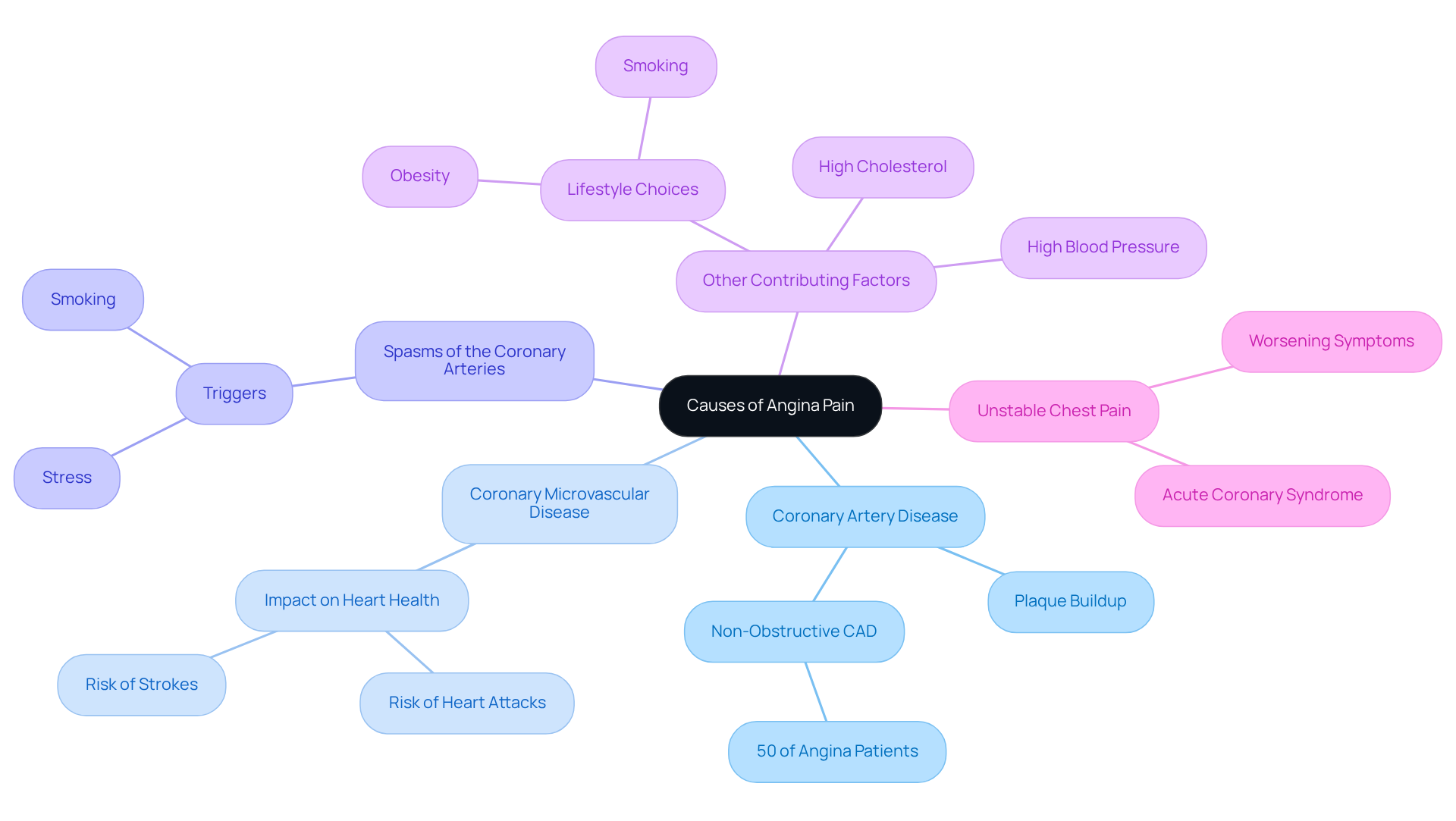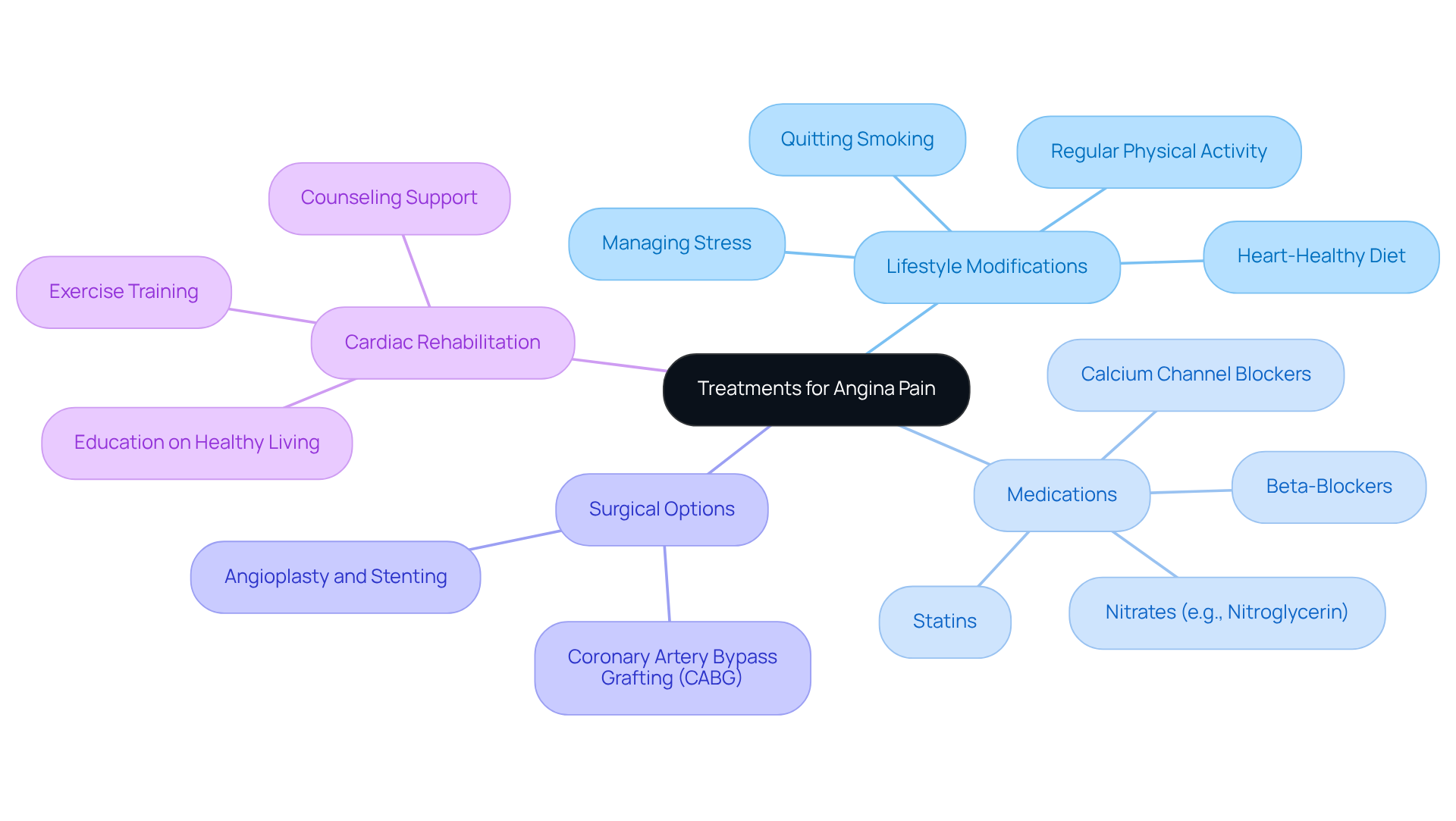


Angina pain often manifests as chest discomfort, a signal that the heart may not be receiving enough oxygenated blood. This can indicate underlying cardiovascular issues, such as coronary artery disease. It's understandable to feel concerned about these symptoms.
Recognizing the signs of angina is crucial, as it opens the door to effective management and prevention of serious heart complications. You might wonder about the treatment options available. Lifestyle changes, along with medical interventions, can make a significant difference in your heart health.
In addition to this, seeking support can alleviate some of the anxiety you may feel. Remember, you are not alone in this journey. There are professionals who care and can guide you through understanding your condition and the steps to take.
Ultimately, it's important to prioritize your heart health and take action. By addressing these concerns with compassion and care, you can pave the way for a healthier future. Don't hesitate to reach out for help; support is just a call away.
Understanding angina pain is crucial for anyone concerned about heart health, as it serves as a significant warning sign of potential cardiovascular issues. This chest discomfort, often described as pressure or tightness, can indicate serious underlying conditions like coronary artery disease, which affects millions annually, especially older adults. As heart-related problems continue to rise, you might wonder: how can you effectively recognize and manage the symptoms of angina pain to prevent more severe complications?
It's essential to be aware of these symptoms and understand that you are not alone in this journey. Many individuals experience similar feelings of anxiety when it comes to heart health. By learning to identify these signs, you can take proactive steps towards your well-being. Remember, reaching out for support is a sign of strength, and there are resources available to help you navigate this concern. Together, we can work towards ensuring a healthier future.
What is angina pain? It refers to the chest discomfort that manifests as a result of inadequate oxygenated blood flow to the heart muscle, also known as angina pectoris. Many describe this sensation as a squeezing, pressure, heaviness, or tightness in the chest. It’s important to understand that angina is not a standalone condition; rather, it serves as a significant warning sign of underlying cardiovascular issues, predominantly coronary artery disease. This condition alerts us that the heart is under stress and may be at risk for serious complications, including heart attacks.
Every year, millions of individuals experience chest pain, particularly those over the age of 60, highlighting its prevalence among older adults. Recent studies reveal that lifestyle factors such as obesity, stress, smoking, and lack of exercise significantly increase the risk of heart-related problems. Additionally, conditions like diabetes, high blood pressure, and elevated cholesterol levels further contribute to this risk.
At Amavita Heart and Vascular Health®, we deeply understand the importance of expert diagnosis and minimally invasive treatment options for managing chest pain and arrhythmias. Our comprehensive cardiac evaluations include advanced imaging and testing all in one location, ensuring precise diagnoses without unnecessary delays. For instance, innovative treatments like the implantation of hourglass-shaped stents have proven effective in improving blood flow and alleviating symptoms for those with coronary microvascular dysfunction. In a recent clinical trial, 76% of participants reported an enhanced quality of life following this procedure.
Cardiologists emphasize the critical nature of identifying what is angina pain as a key symptom. They note that while stable chest pain can often be managed through lifestyle changes and medications, unstable chest discomfort—characterized by worsening episodes or attacks occurring at rest—requires immediate medical attention. At Amavita, our preventive cardiology approach combines advanced risk evaluation tools with personalized interventions, including lifestyle modifications, to develop strategies that significantly reduce the risk of cardiac events.
Ongoing research continues to delve into the complexities of angina pectoris, helping to clarify what is angina pain and revealing that its severity does not always correlate with the level of oxygen deprivation in the heart. This underscores the need for continuous exploration to enhance treatment strategies and improve outcomes for this prevalent yet serious condition. Through our CardioElite™ program, we are committed to transforming cardiac care by providing comprehensive management and reducing readmissions, ensuring that individuals receive the highest quality of care tailored to their unique needs.

Symptoms of angina pain can vary significantly among individuals, but they typically include:
Recognizing these symptoms is crucial, as they can indicate what is angina pain and the need for immediate medical evaluation. For instance, a case study emphasized a father who misunderstood his heart attack symptoms as back pain, underscoring the significance of awareness and education concerning chest pain. Recent studies from heart specialists highlight that early identification and action can greatly enhance outcomes for patients facing chest pain. This makes it essential for individuals to seek advice from healthcare professionals when observing these symptoms. Furthermore, demographic factors indicate that this condition is more common among Black and Latino cisgender females and White cisgender males, further highlighting the necessity of focused awareness initiatives.

Angina pain primarily arises from reduced blood flow to the heart muscle, often linked to several key factors that are important to understand:
Coronary Artery Disease (CAD): This is the leading cause of angina, characterized by the buildup of plaque in the coronary arteries. This narrowing restricts blood flow, and it's worth noting that almost 50% of patients with chest pain suffer from non-obstructive coronary artery disease. This complexity highlights the need for thorough evaluation and care.
Coronary Microvascular Disease: This condition affects the tiny vessels of the cardiovascular system, resulting in chest pain even when the major arteries appear unobstructed. It is crucial to recognize that microvascular chest pain can significantly impact heart health, potentially leading to serious consequences like heart attacks and strokes.
Spasms of the Coronary Arteries: Temporary constriction of the muscles within the coronary arteries can also decrease circulation, leading to chest pain. These spasms can occur unpredictably and may be triggered by stress, smoking, or other factors, which can understandably cause concern.
Other Contributing Factors: Conditions such as high blood pressure and high cholesterol, along with lifestyle choices like smoking and obesity, play a significant role in the onset of chest pain. Managing these risk factors is essential for effective prevention and treatment. At Amavita Heart and Vascular Health®, we are dedicated to employing advanced risk evaluation instruments and tailored strategies to assist patients in managing these factors, ultimately aiming to lower their risk of attacks.
Unstable Chest Pain: This type of discomfort is associated with acute coronary syndrome and requires urgent medical attention. It is characterized by worsening symptoms and can occur at rest, which can be alarming.
Understanding what is angina pain is vital for developing effective management strategies. As noted by cardiologists, addressing lifestyle-related factors and medical conditions can greatly lower the risk of chest pain and enhance overall cardiovascular health. Through our CardioElite™ program, we provide advanced, data-driven care that not only enhances patient management but also reduces readmissions. Our goal is to ensure that individuals receive the comprehensive support they need for optimal heart health, fostering a sense of security and well-being.

When it comes to treating chest pain, a compassionate and comprehensive approach is essential. This often includes lifestyle changes, medications, and, in some cases, surgical procedures that can make a significant difference in your health and well-being.
Lifestyle Modifications: Embracing a heart-healthy diet, engaging in regular physical activity, quitting smoking, and managing stress effectively can greatly reduce both the frequency and severity of chest pain episodes. Many individuals who make these positive changes report a noticeable improvement in their quality of life and a decrease in symptoms. Have you considered how small adjustments in your daily routine could lead to big changes in how you feel?
Medications: There are various medications that doctors often prescribe to help manage chest pain. Nitrates, such as nitroglycerin, can provide quick relief from symptoms. Additionally, beta-blockers and calcium channel blockers help regulate heart rate and blood pressure, while statins work to lower cholesterol levels. It's worth noting that over 500,000 stenting procedures are performed globally each year to address angina, highlighting the importance of both medication and procedural options.
Surgical Options: In certain situations, surgical interventions like angioplasty and stenting or coronary artery bypass grafting (CABG) may be necessary to restore adequate blood flow to the heart. For those dealing with severe coronary artery disease, these procedures can be life-changing and restore hope for a healthier future.
Cardiac Rehabilitation: Participating in a structured cardiac rehabilitation program can be incredibly beneficial. These programs typically include exercise training, education on healthy living for your heart, and counseling support. This holistic approach not only aids in physical recovery but also empowers you with the knowledge and skills needed to manage your condition effectively. Remember, you are not alone on this journey; support is available to help you thrive.
Understanding these treatment options is crucial for you to take proactive steps in managing what is angina pain and improving your overall heart health. If you have concerns or questions, please don’t hesitate to reach out for support. Your heart health matters, and there are caring professionals ready to assist you.

Understanding angina pain is essential for recognizing the warning signs of potential heart issues and seeking timely medical intervention. This condition, characterized by chest discomfort due to inadequate blood flow to the heart, serves as a crucial indicator of underlying cardiovascular problems. By identifying the symptoms, causes, and treatment options available, individuals can take proactive steps towards safeguarding their heart health.
The article highlights various symptoms associated with angina pain, such as:
It's important to understand the causes, including:
Furthermore, the discussion on treatment options underscores the significance of:
Ultimately, awareness and education about angina pain can lead to better health outcomes. Are you recognizing the symptoms? Consulting healthcare professionals for personalized care plans can make a significant difference. Embracing heart-healthy lifestyle changes and staying informed about treatment options can greatly enhance your quality of life and reduce the risk of serious cardiovascular issues. Taking action today can pave the way for a healthier tomorrow, and remember, you are not alone on this journey.
What is angina pain?
Angina pain refers to chest discomfort resulting from inadequate oxygenated blood flow to the heart muscle, also known as angina pectoris. It is often described as a squeezing, pressure, heaviness, or tightness in the chest.
Is angina a standalone condition?
No, angina is not a standalone condition; it is a significant warning sign of underlying cardiovascular issues, primarily coronary artery disease, indicating that the heart is under stress and at risk for serious complications, including heart attacks.
Who is most likely to experience angina pain?
Angina pain is particularly prevalent among older adults, especially those over the age of 60, with millions experiencing chest pain each year.
What lifestyle factors increase the risk of angina?
Lifestyle factors that significantly increase the risk of heart-related problems include obesity, stress, smoking, and lack of exercise. Additionally, conditions like diabetes, high blood pressure, and elevated cholesterol levels further contribute to this risk.
How does Amavita Heart and Vascular Health® approach angina diagnosis and treatment?
Amavita Heart and Vascular Health® provides expert diagnosis and minimally invasive treatment options for managing chest pain and arrhythmias, including advanced imaging and testing for precise diagnoses. They offer innovative treatments like hourglass-shaped stents to improve blood flow and alleviate symptoms.
What is the difference between stable and unstable angina?
Stable angina can often be managed through lifestyle changes and medications, while unstable angina is characterized by worsening episodes or attacks occurring at rest and requires immediate medical attention.
How does Amavita address preventive cardiology?
Amavita employs a preventive cardiology approach that combines advanced risk evaluation tools with personalized interventions, including lifestyle modifications, to develop strategies that significantly reduce the risk of cardiac events.
What ongoing research is being conducted on angina pectoris?
Ongoing research continues to explore the complexities of angina pectoris, clarifying what angina pain is and revealing that its severity does not always correlate with the level of oxygen deprivation in the heart, thus enhancing treatment strategies and improving outcomes.
What is the CardioElite™ program?
The CardioElite™ program at Amavita is committed to transforming cardiac care by providing comprehensive management and reducing readmissions, ensuring individuals receive high-quality care tailored to their unique needs.